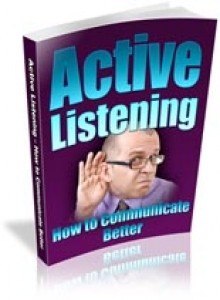
 License Type: Private Label Rights
License Type: Private Label Rights  File Size: 1,097 KB
File Size: 1,097 KB File Type: ZIP
File Type: ZIP
 SKU: 3929
SKU: 3929  Shipping: Online Download
Shipping: Online Download
Ebook Sample Content Preview:
The first step is to accept that improvement is possible and necessary. Once this has been done, there are specific skills that can be learned so that you can almost instantly become an active listener and more effective communicator. Practice, however, is the key to your success. Only through the repeated application of these skills will they become second nature to you.
Bear in mind that body language is a large part of active listening. You may be perfectly able to actively listen lying on your back on a bed with your eyes shut, but that will not convince the speaker that you are paying full attention, and may cause them to be reticent with their information, or not to bother at all.
Face the speaker – It is important to adopt the correct physical attitude. Slouching in a chair that is facing a window whilst the speaker is placed to one side of you does not create the right impression. You should be sitting up straight, your body facing the speaker and canted slightly forward to show your interest through positive body language.
Maintain eye contact – This does not mean never blinking or looking away. There needs to be a comfortable and comforting degree of eye contact when two people are communicating. Where eye contact is broken, it should not be to take an interest in someone or something else. It is pretty obvious when this is happening. There is no magic formula for when to break eye contact, for how long, and where else to look. Just remember that eye contact will be largely governed by how genuinely interested you are in what the speaker is saying. If you have no interest, or are not concentrating with active listening, then you can be fairly confident that your level of eye contact will be giving the game away.
Assess the emotion, not just the words – Active listening also involves actively analyzing the speaker’s body language, tone of voice and facial expressions. Very often, words on their own are a poor guide as to how a person is feeling. Sometimes they are in direct contradiction. If communication is to be effective, it must be honest, so the goal of active listening is to decipher the truth of a situation, Even if the speaker comes to you, don’t assume that they will be straight-talking. They may want you to look behind the words at their body language, because they may need the truth coaxed out of them if it is too painful to simply utter.
Minimize external distractions – Trying to speak or listen when there are distractions around you is difficult. You need to turn off the TV, switch off the radio, stop reading, stop writing, and just pay attention. The speaker must also cease any distracting activities.
Respond appropriately – If you are genuinely taking an interest and listening, this should take care of itself. However, do bear in mind that some people are less animated than others, and if you are like this, you may want to insert a few nods or verbal acknowledgements. It may help to say you understand or offer other spoken encouragements every so often. Be careful not to overdo it, though. Saying “wow”, “really?”, and “fascinating” every few seconds can be distracting in itself, or it may seem false, as though you are sticking to some formula you read in a book. You can also ask questions, provided they do not interrupt the flow of the speaker’s thoughts.







